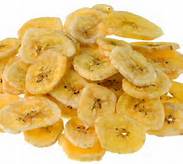Dehydrating Bananas

Dehydrating bananas is one way to preserve this nutritious fruit, which can ripen quickly as well as go bad. Including bananas in your stored provisions provides the possibility of banana bread, flavoring for your cereal or just a healthy snack.
Flavor is only one of the reasons to include bananas in your food provisions. Bananas are popular snacks for athletes and hikers and they can provide the same benefits to preppers as they contain:
- Carbohydrates
- Fiber
- Magnesium
- Potassium
- Manganese
- Copper
- Vitamin B6
- Trace amounts of other vitamins and minerals such as vitamin A and C, calcium and iron
Choosing Bananas
Some people who have experience dehydrating bananas recommend green bananas, others encourage using ripe bananas, while others advocate overripe bananas, as they are sweeter. You can also dehydrate plantains that are a type of banana but starchier and more like a vegetable. You should experiment with dehydrating the different types to see which provides the taste that you and your family enjoy and works best in your style of cooking.
Preparation
You can peel the bananas and slice them to a width to match your preference of crispiness of the chips. If you like them crispy, slice the bananas from 1/16 to 1/4 inch but slice them a little thicker if you would like them to be chewy. You can sprinkle nutmeg or cinnamon on the slices before dehydrating bananas.
Another way to prepare the banana is to peel it and remove the little knob at the end of it. Push your finger up the center of the banana from the bottom and it will fall apart in thirds. You will have banana slices as opposed to chips.
Pretreatment of Bananas
Pretreatment of the slices or pieces can keep the bananas from turning brown, which is a cosmetic feature and does not effect the nutritious values of the food. You can use juice such as lemon, lime or orange juice or ascorbic acid to soak the bananas to prevent browning.
You can also pretreat using honey when you are dehydrating bananas. You warm the honey and put your banana slices or pieces in it. If you drag the pieces along the side of the bowl, the extra honey will run back into the bowl and you will have less honey on your dryer racks. Honey dipped banana take a couple hours longer and are good for short-term storage as well as snacking right away.
Heating
Dehydrate the chips from 120 to 135 degrees Fahrenheit or 49 to 57 degrees Centigrade. It is important to apply low heat slowly as if the outside of the chips or slices dry before the inside, it will trap the moisture inside.
The time it takes for dehydrating bananas ranges from 12 hours to days depending on various factors including whether you are using drying racks in the sun or a Nesco or Excalibur dehydrator powered with electricity. The difference can be as basic as the climate in which you live as one Florida woman reported that it took three to six days to make banana chips due to the humidity.
Shelf Life
The shelf life of the homemade banana chips is anywhere from two months to many years, depending on:
- Moisture content of the bananas - the less moisture, the longer the shelf life
- Exposure to light - the less light, the longer the shelf life
- Temperature where they are stored- the cooler the temperature, the longer the shelf life
- Air tight packaging - the less oxygen in the packaging and the more protection from moisture in the air, the longer the shelf life.
Before eating, you should always check for signs of spoilage on any preserved product that you have stored, not only bananas.
Dehydrating bananas is something that you should practice to find the best process that works for you or you can purchase MyChoice dehydrated banana slices at beprepared.com or Saratoga Farms dehydrated slices at the ReadyStore. In a post apocalyptic world, you may not have bananas to continue to process once the stores close, but for short term emergencies, a ready supply of nutritious banana chips or pieces is something which could ease the burden of food gathering when the stores simply do not have supplies.
Return from Dehydrating Bananas to DIY Food Storage





New! Comments
Have your say about what you just read! Leave me a comment in the box below.